
Top VLSI Engineer Skills in 2025: What Companies Actually Want
Mar 06, 2025 6 Min Read 6720 Views
(Last Updated)
VLSI engineer skills have nowhere near met the semiconductor industry’s expansion in 2024. Your VLSI design engineer expertise creates microchips and integrated circuits that power today’s electronic devices.
Leading companies actively look for professionals with strong fundamentals in digital and analog circuit design. They also value proficiency in CAD tools and programming languages like Verilog and VHDL. Your success depends on a blend of technical expertise and soft skills that include creativity, problem-solving abilities, and clear communication.
This complete guide outlines the must have VLSI engineer skills in 2025. You will discover the technical requirements, software proficiency, and personal qualities that top companies value in their VLSI engineering talent.
Table of contents
- What is VLSI Design?
- What do VLSI Engineers Do?
- The Top 5 Must-Have VLSI Engineer Skills
- Core Technical Skills
- Backend VLSI Skills
- Software and Programming Skills
- Verification and Testing Skills
- Soft Skills
- Concluding Thoughts…
- FAQs
- Q1. What are the essential skills for a VLSI engineer in 2025?
- Q2. How much can a VLSI engineer expect to earn after 5 years of experience?
- Q3. What are some of the best companies for VLSI engineers?
- Q4. How important are soft skills for VLSI engineers?
- Q5. What does the future hold for VLSI engineers?
What is VLSI Design?
VLSI (Very Large Scale Integration) emerged in the 1970s as a way to combine millions or billions of MOS transistors on a single semiconductor chip. This revolutionary technology altered the map of electronic systems and paved the way for highly sophisticated integrated circuits (ICs).
VLSI design is a vital part of modern electronics that blends principles of electronics, computing, and digital logic. The technology powers high-performance semiconductor chips, which industry leaders like Intel, Qualcomm, Apple, and IBM use in their microprocessors.
What do VLSI Engineers Do?
VLSI engineers shape the future of semiconductor technology that powers sophisticated electronic devices. These experts design and develop integrated circuits at the heart of modern electronic systems.
VLSI engineering offers several specialized roles. Physical design engineers turn logical designs into manufacturable layouts. Verification engineers run tests to ensure circuits work as intended. Analog/mixed-signal design engineers build components that bridge digital and analog worlds.
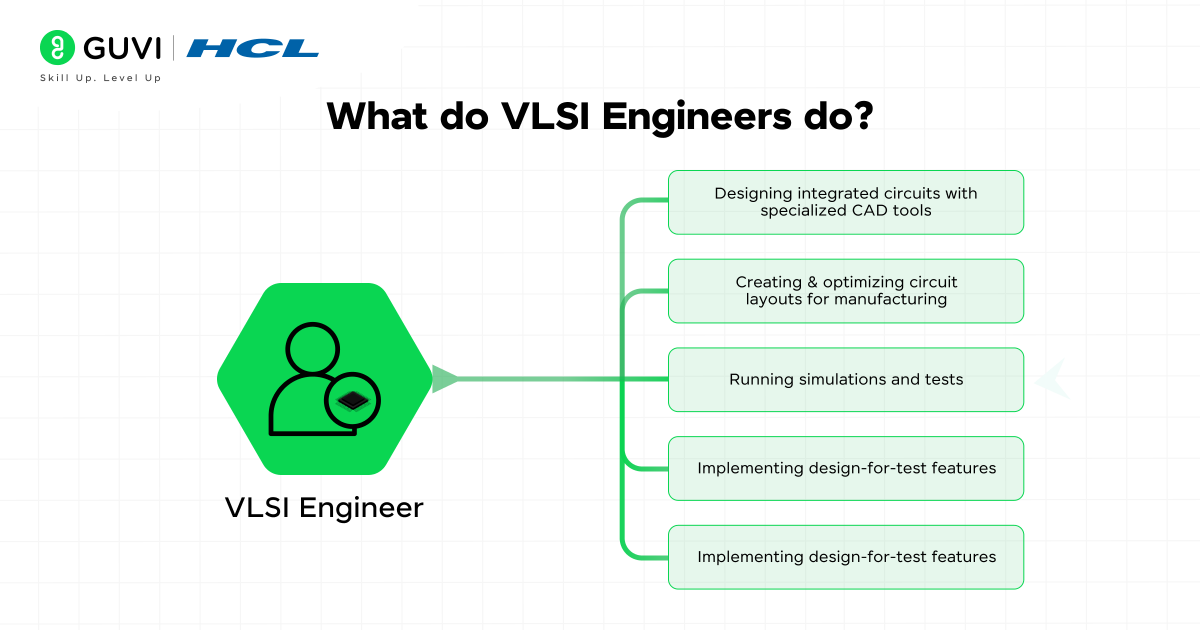
A VLSI engineer’s core responsibilities include:
- Designing integrated circuits with specialized CAD tools
- Creating and optimizing circuit layouts for manufacturing
- Running simulations and tests
- Implementing design-for-test features
- Working together with cross-functional teams for product development
VLSI engineers team up with many stakeholders during development cycles. They analyze system requirements and write detailed specifications during the design phase. They then use computer-aided design tools to create circuit plans and adjust them based on performance, power use, and costs.
The Top 5 Must-Have VLSI Engineer Skills
Now that we’ve gained a fair understanding of what VLSI design is and what VLSI engineers do, we will move on to discussing what skills you’ll need to become a VLSI engineer. Let’s begin.
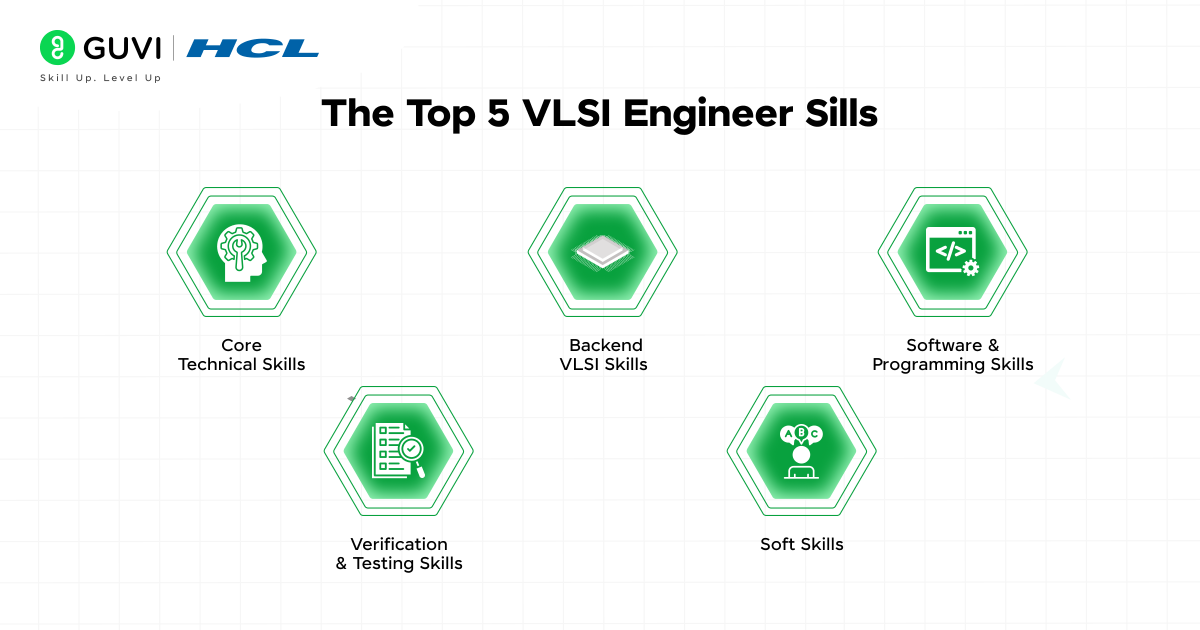
1. Core Technical Skills
To excel as a VLSI (Very Large Scale Integration) engineer, you must have a strong foundation in core technical skills that cover circuit design, semiconductor physics, hardware description languages (HDLs), and industry-standard EDA tools. These skills are essential for designing, testing, and optimizing integrated circuits (ICs) that power modern electronic devices.
- Digital and Analog Circuit Design
VLSI engineers work extensively with digital and analog circuits, forming the backbone of semiconductor design. To succeed in this field, you must master the following:
- Digital Circuit Design:
You should be proficient in Boolean algebra, logic gates, flip-flops, multiplexers, registers, counters, and finite state machines. These concepts help in designing combinational and sequential circuits used in microprocessors, memory units, and digital logic systems. You must also understand clocking techniques, pipelining, and power optimization to create energy-efficient digital designs. - Analog Circuit Design:
Unlike digital circuits, analog design deals with continuous signals and requires an understanding of MOSFETs, BJTs, operational amplifiers (op-amps), voltage regulators, filters, and signal conditioning circuits. You must be able to design low-noise amplifiers (LNAs), phase-locked loops (PLLs), and ADC/DAC converters to ensure seamless analog-to-digital and digital-to-analog conversions.
A deep knowledge of signal integrity, power integrity, and mixed-signal design is essential for developing robust ICs used in telecommunications, IoT, and embedded systems.
- Semiconductor Physics
A VLSI engineer must have a solid grasp of semiconductor physics, which forms the foundation of transistor design and fabrication. The key concepts include:
- MOSFET (Metal-Oxide-Semiconductor Field-Effect Transistor) Principles:
You should understand how MOSFETs function as switches in digital circuits and amplifiers in analog circuits. Mastering threshold voltage, subthreshold conduction, leakage current, and short-channel effects is crucial for designing power-efficient chips. - CMOS Technology:
Complementary Metal-Oxide-Semiconductor (CMOS) is the most widely used IC technology. You must know CMOS logic families, power consumption factors, scaling effects, and fabrication challenges. CMOS design principles help in reducing static and dynamic power dissipation, making it the preferred choice for modern processors and memory units. - Semiconductor Fabrication:
Understanding the fabrication process (lithography, doping, etching, and deposition techniques) is crucial for translating circuit designs into physical silicon chips. Knowledge of SOI (Silicon-on-Insulator), FinFET, and gate-all-around (GAAFET) technologies will give you an edge in next-generation chip design.
Having a firm understanding of device physics, quantum effects in nanoscale transistors, and emerging materials like GaN and SiC can set you apart as a VLSI expert.
- HDL Programming
Hardware Description Languages (HDLs) are used to model, simulate, and synthesize digital circuits. The two most widely used HDLs are:
- Verilog:
Verilog is widely used in RTL (Register Transfer Level) design, FPGA prototyping, and ASIC development. You must learn procedural blocks, always blocks, testbenches, and synthesis directives to write efficient digital logic designs. - VHDL (VHSIC Hardware Description Language):
VHDL is commonly used for high-reliability applications like aerospace, defense, and automotive electronics. It has a strongly-typed syntax that makes it ideal for large-scale, complex designs.
To excel in HDL programming, you should master state machines, pipelining techniques, clock domain crossing (CDC), and power-aware coding practices. Familiarity with SystemVerilog and UVM (Universal Verification Methodology) is also valuable for advanced verification tasks.
- EDA Tools
Electronic Design Automation (EDA) tools are indispensable for VLSI engineers, as they streamline the design, simulation, verification, and fabrication of semiconductor devices. The most important EDA tools include:
- Cadence Virtuoso: Used for analog/mixed-signal IC design, layout, and simulation. It helps in designing complex circuits at the transistor level.
- Synopsys Design Compiler: A key tool for logic synthesis, RTL optimization, and gate-level netlist generation for ASICs.
- Xilinx Vivado & Intel Quartus: Industry-standard tools for FPGA design, synthesis, and implementation.
- ModelSim & QuestaSim: Widely used for HDL simulation, debugging, and functional verification.
- Mentor Graphics & Cadence Xcelium: Popular for formal verification, timing analysis, and power estimation in VLSI circuits.
Proficiency in these tools will enable you to design low-power, high-performance, and scalable semiconductor solutions for AI, 5G, automotive, and IoT applications.
2. Backend VLSI Skills
Backend VLSI design skills connect logical circuit descriptions with manufacturable silicon layouts. These skills help you turn abstract circuit ideas into real physical implementations that deliver the required performance.
- Physical Design
Physical design turns circuit representations into geometric shapes so components work correctly. The process starts with netlist conversion and moves through layout creation.
Your physical design skills must include:
- Floor planning and partitioning
- Power distribution network design
- Placement and routing optimization
- Clock tree synthesis
- Design rule checking (DRC)
- Layout versus schematic (LVS) verification
You’ll work with Process Design Kits (PDKs) that provide vital information about manufacturing processes, device models, and design rules. These kits serve as a bridge between foundry requirements and design tools.
- Static Timing Analysis (STA)
We used STA to confirm design performance by looking at all possible timing paths. This method splits the design into timing paths and calculates how signals travel to find potential issues.
You’ll need to know setup and hold constraints well. Setup constraints define how long data must be ready before clock capture to meet maximum delay requirements. Hold constraints make sure data remains stable after clock capture.
- Power and Signal Integrity Analysis
Power integrity analysis has become a big deal as it means we need detailed evaluation of power distribution networks (PDN). Your job is to ensure stable voltage delivery throughout the chip while reducing noise and keeping signal quality high.
Power and signal integrity skills help create designs that provide clean, stable power while maintaining signal quality in high-speed interconnects. These capabilities are vital to develop reliable, high-performance integrated circuits that meet modern electronic system needs.
If you’re looking to master all these VLSI Design and Verification skills and launch a successful career as a VLSI Engineer, then GUVI’s VLSI Design & Verification Course is your gateway to the semiconductor industry.
This course covers RTL design, FPGA prototyping, ASIC flow, verification methodologies, and industry-standard tools like Verilog, VHDL, and SystemVerilog—all essential for thriving in chip design and fabrication. Learn from industry experts, gain hands-on experience, and become job-ready for top VLSI companies.
3. Software and Programming Skills
Software programming skills enhance your hardware expertise in VLSI design. You can automate and analyze complex circuits more efficiently. These skills cover scripting languages, hardware modeling tools, and signal processing platforms.
- Scripting Languages
Scripting languages are great tools that automate repetitive tasks in VLSI design flows. Python, TCL (Tool Command Language), and Perl have become crucial to process tool outputs and create efficient design processes. These languages let you:
- Parse complex log files and generate reports
- Automate design rule checks
- Create custom verification flows
- Interface with Electronic Design Automation (EDA) tools
- Manage version control and documentation
TCL stands out as the preferred language for tool interfaces because most EDA tools support TCL-based automation. Knowing how to use TCL helps you customize tool behavior and create efficient design workflows.
- C/C++ for Hardware Modeling
C/C++ is crucial in hardware modeling and verification. It brings unique advantages to VLSI design. Engineers model circuits and systems with C/C++, run functional simulations, and then convert specific portions into hardware description languages.
This approach adds significant value to your design process. C++ comes with advanced data structures and standard libraries that help develop quick behavioral models. You can create models that simulate hardware component functionality without the memory and simulation time overhead of equivalent HDL behavioral models.
- MATLAB for Signal Processing
MATLAB and Simulink are key tools for signal processing applications in VLSI design. These platforms are a great way to get capabilities for analyzing signals and testing algorithms at various development stages.
Your MATLAB skills let you use built-in functions for time-series data analysis, spectral analysis, and signal measurements. MATLAB excels at designing and implementing digital filters, from simple FIR and IIR filters to advanced adaptive designs.
The platform generates C/C++ or HDL code automatically for deployment on embedded processors, FPGAs, and ASICs. This feature makes the transition from algorithm development to hardware implementation smoother, making MATLAB an essential tool in your VLSI engineering toolkit.
4. Verification and Testing Skills
VLSI design’s life-blood lies in verification and testing expertise that ensures integrated circuits’ reliability and functionality. These skills matter more than ever since verification takes up to 70% of VLSI design projects’ time and cost.
- Functional Verification
Functional Verification helps you prove design behavior matches specifications. You create complete test scenarios to simulate ground operating conditions. Universal Verification Methodology (UVM) has become the industry standard that provides a framework to create flexible and reusable testbenches.
- Design for Testability (DFT)
Design for Testability (DFT) techniques boost your testing capabilities beyond functional verification’s foundations. DFT implementation adds features like scan chains and boundary scan testing that end up cutting testing costs while improving product quality.
Your testing methodologies expertise should cover both pre-silicon and post-silicon validation. Automatic Test Pattern Generation (ATPG) helps detect specific circuit faults. Built-In Self-Test (BIST) capabilities work alongside these approaches to automatically repair faulty components and improve chip yield.
- Static Timing Analysis (STA)
Static Timing Analysis (STA) plays a vital role in proving timing requirements. This method analyzes timing paths from source to destination to ensure signals reach their intended destinations within required clock cycles. Power integrity analysis has grown significantly and needs complete evaluation of power distribution networks.
Your verification strategy should achieve high fault coverage with minimal tests. We combined simulation-based techniques with formal verification methods to analyze design behavior thoroughly. The process needs coverage metrics, including statement coverage, branch coverage, and toggle coverage to measure verification effectiveness.
5. Soft Skills
VLSI engineering success goes way beyond technical prowess. A strong foundation of interpersonal and cognitive abilities plays the most important role. These soft skills work alongside your technical expertise to help you excel in complex semiconductor projects.
- Analytical and Problem-Solving Skills
Your analytical thinking acts as a compass throughout your VLSI career. It guides you through intricate design challenges. Strong problem-solving abilities help you tackle complex circuit issues and create innovative solutions that optimize designs. Your methodical approach to problems and ability to see multiple angles makes you stand out in the field.
- Attention to Detail
VLSI design demands absolute precision. A single oversight can trigger major manufacturing issues or performance problems. Your careful eye on design specifications, layout rules, and potential errors leads to flawless designs. Of course, this thorough approach maintains high quality standards while meeting tight project deadlines.
- Teamwork and Communication
VLSI projects thrive on collaborative efforts. They need uninterrupted interaction in a variety of teams. Your communication skills become vital when you:
- Explain complex technical concepts to non-technical stakeholders
- Document detailed yet concise design specifications
- Present project updates to management
- Work with cross-functional teams
Effective communication speeds up problem-solving as different viewpoints often spark innovative solutions. Your technical expertise matters, but knowing how to work smoothly with teams determines project success. Strong interpersonal relationships create productive work environments that follow industry best practices.
Concluding Thoughts…
VLSI engineering combines technical expertise with interpersonal skills. Your success in this field depends on your mastery of hardware fundamentals and modern software tools. Every detail matters in this discipline.
A skilled VLSI engineer should possess:
- Deep understanding of digital and analog circuit design
- Proficiency in HDL programming and EDA tools
- Strong backend design capabilities
- Advanced verification and testing knowledge
- Key soft skills that enable team collaboration
These skills become valuable as semiconductor technology grows faster. Companies look for professionals who blend traditional circuit design knowledge with modern programming and verification expertise.
FAQs
A VLSI engineer in 2025 should possess a combination of core technical skills, software proficiency, and soft skills. These include expertise in digital and analog circuit design, proficiency in HDL programming and EDA tools, strong backend design capabilities, advanced verification and testing knowledge, and essential interpersonal skills for effective collaboration.
A VLSI engineer with 5 years of experience can earn between ₹15-25 LPA in India, depending on expertise, location, and company.
Some of the top companies for VLSI engineers include ARM, Infineon Technologies (formerly Cypress Semiconductor), Analog Devices, and Broadcom. These companies are known for their innovative work in semiconductor technology and offer excellent opportunities for career growth in VLSI design.
Soft skills are crucial for VLSI engineers. Strong analytical and problem-solving abilities, meticulous attention to detail, and excellent teamwork and communication skills are essential. These skills complement technical expertise and are vital for success in complex semiconductor projects and collaborative work environments.
The future of VLSI engineering is promising, with numerous opportunities and challenges. Emerging technologies like quantum computing and brain-machine interfaces are opening new avenues for VLSI applications. Engineers can expect to work on innovative products and applications, with a continued focus on miniaturization, power efficiency, and performance enhancement in semiconductor design.

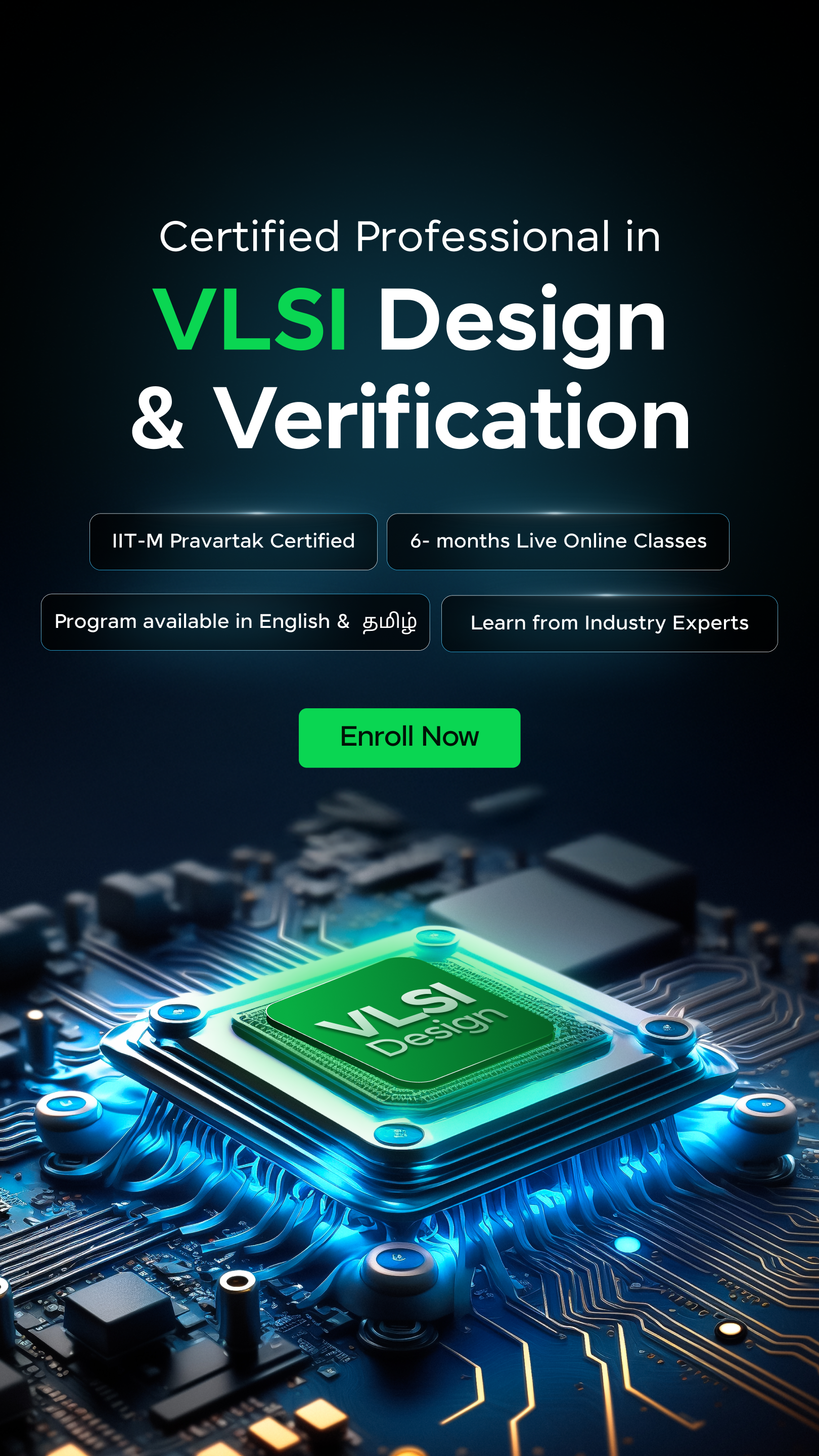



















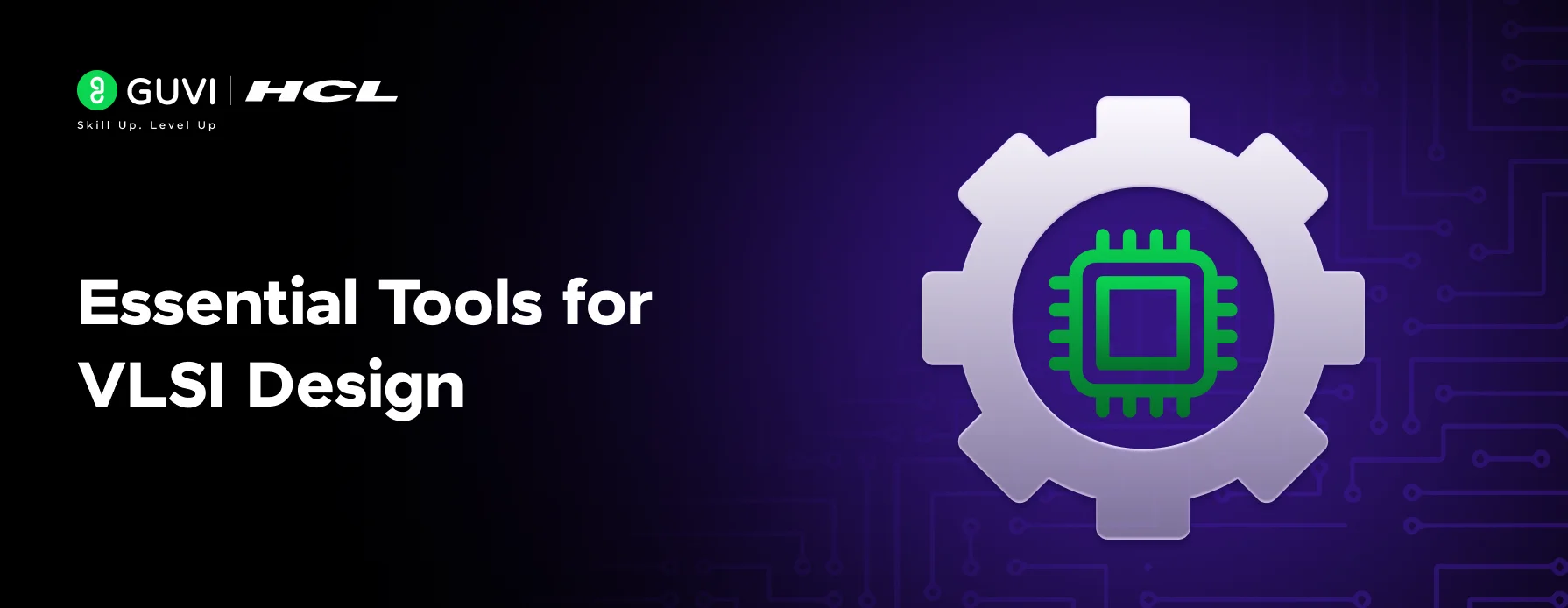
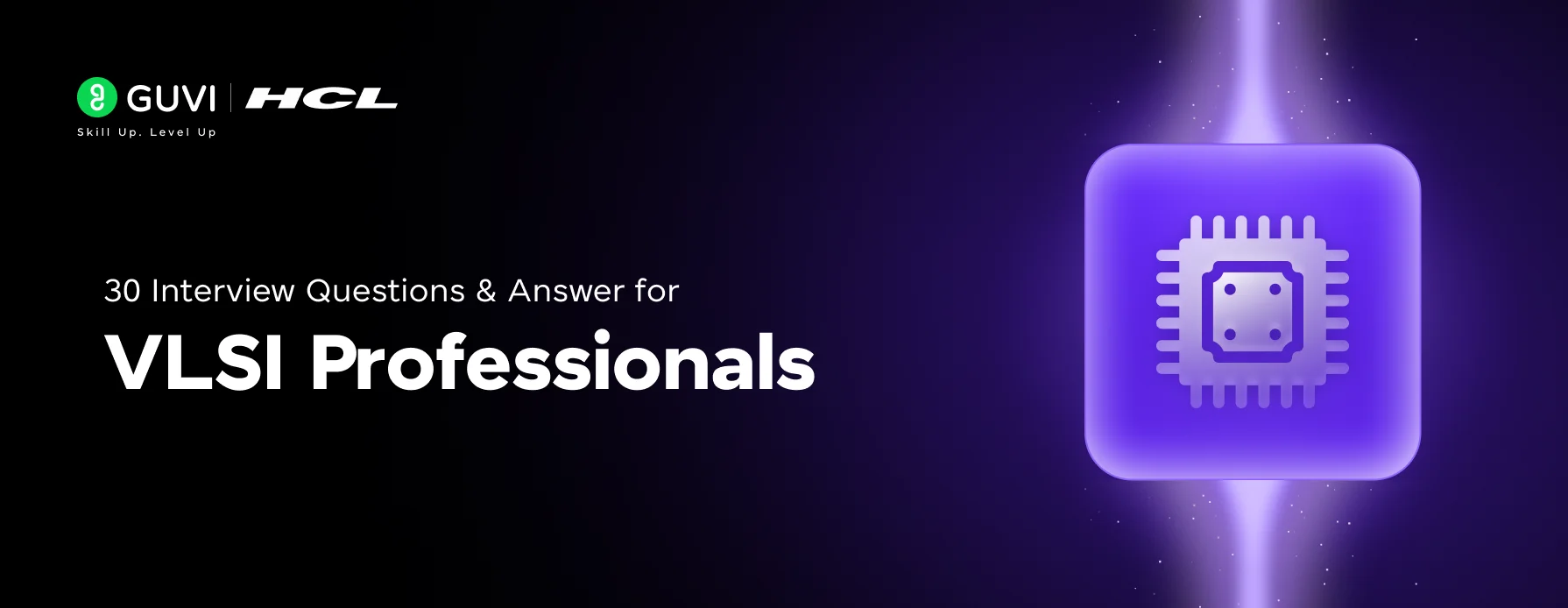
![Top 8 VLSI Design Job Roles [2025] 6 vlsi design job roles](https://www.guvi.in/blog/wp-content/uploads/2025/03/Top-8-VLSI-Design-Job-Roles.png)







Did you enjoy this article?